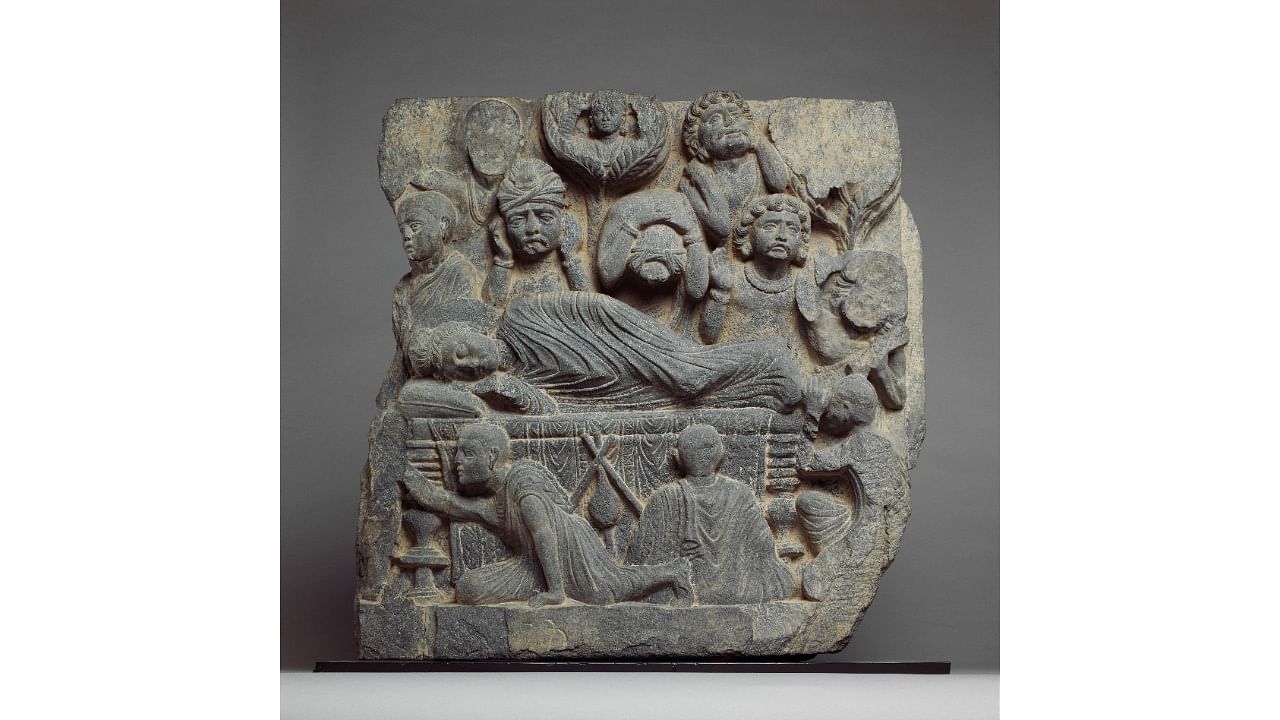
'The Death of the Buddha', 3rd century.
Pic courtesy: MET museum
Many Buddhist sculptures and reliefs with features borrowed from Greek and Iranian mythological figures have been found in the ancient Gandhara region, in present-day Pakistan. Although South Asian in their subject matter and content, the figures are rendered in a naturalistic style distinctly Greco-Roman, seen in their subtly toned physiques and the folds of their heavy robes, typical moustaches and hairstyles. The Bodhisattva Maitreya, for example, is distinguished by his looped knot and the water flask in his left hand; and he dons the traditional garb of an Indian prince. But the meticulously draped folds of his dhoti and his muscular torso betray the influence of Greco-Roman sculptural traditions.
Situated at a geographical crossroads between the Mediterranean world and South and Central Asia, the multicultural diversity of Gandhara resulted in an artistic style known for its unique syncretic character, which combines stylistic and iconographic influences from all these regions.
At Gandhara, the winged figure of Atlas, who held up the world on his shoulders in Greek mythology, was often positioned at the base of architectural structures such as Buddhist stupas, symbolically holding it up. Greco-Roman sculptural prototypes depicting wrestling figures were also adapted to illustrate scenes from the Buddha’s life. Panels depicting inebriated figures holding wine cups, drinking, dancing and making music were carved on the lower portions of public monuments. Since these were scenes of merriment, accompanying the consumption of alcohol, the images have been referred to as ‘Bacchanalian’ or ‘Dionysian’, after the Roman and Greek gods of wine and ecstasy, Bacchus and Dionysus, respectively.
As with most Gandharan art, there is some ambiguity around the influences for the drinking scenes, which seem to simultaneously draw on Hellenistic, Roman, Egyptian or Ptolemaic, Hindu, Buddhist and Zoroastrian cultures in both style and subject matter. While some scholars consider the scenes to be an aspect of the cult of Dionysus, and therefore, a product of Hellenistic influence on Gandharan art — others highlight a more indigenous source for the images in the ancient cults of yakshas and yakshis, who were ritually offered meat and alcohol and were custodians of amrita, or the elixir of eternal life. Scholars speculate that Dionysus was conflated with Indra, the Hindu king of heaven, in the Gandharan context. Other objects that combined the attributes of Greco-Roman deities with local traditions include a gold coin depicting a goddess holding a cornucopia like the Greco-Roman goddess, Tyche, while also clasping a lotus flower associated with the Indian goddess of good fortune, Shri or Lakshmi.
These objects underscore how Greco-Roman symbols, mythological figures and themes were appropriated and given new meanings in the Gandharan context — which defy the binaries of Hellenism and Buddhism as well as of indigenous and foreign influences — chronicling a lively exchange that disrupts our neat notions of modern geographical borders.
Discover Indian Art is a monthly column that delves into fascinating stories on art from across the sub-continent, curated by the editors of the MAP Academy. Find them on Instagram as @map_academy or write to them at hellomapacademy@map-india.org